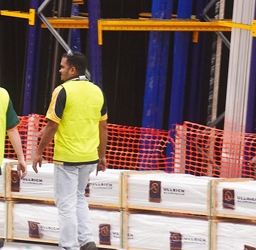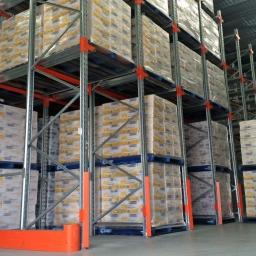
The planning of your warehouse layout will have a lasting impact on the success of your warehouse. In fact, the layout of a warehouse will impact everything from storage capacity, productivity, and output, to equipment damage and even worker safety.
Whether you’re planning the layout of a new facility or redesigning an existing warehouse, taking the time to thoroughly plan out your warehouse layout will help to streamline your warehouse operations, reduce expenses, and maximise storage capacity.
Pallet racking is an essential component of any warehouse layout as it will help to determine storage capacity, aisle size and layout, inventory access, and more. When it comes to warehouse pallet racking, Macrack are the experts. Manufacturing quality pallet racking systems in Australia for over 30 years; if you want expert advice for your new warehouse layout, Macrack are the team to call. Talk to one of our warehouse storage experts today on 1800 048 821 or read on for our top tips when planning your warehouse layout.
3 Factors To Consider When Planning Your Warehouse Layout
1) Flow
When it comes to planning a warehouse layout, product storage is not the only factor to consider. While maximising product storage will ensure that you can store as much inventory as possible, the flow and daily operations of a warehouse should also be considered when determining layout, rather than just trying to squeeze in as many rows of racking as possible.
Ensuring that your warehouse layout allows workers to move freely through the space without undue delays or obstructions will increase productivity and efficiency and can also reduce the risk of workplace accidents. Consider where the high-traffic areas will be and set out designated traffic routes to prevent queuing and collisions.
Additionally, take into account where workers will be stationed, ensuring that they have quick access to the materials that they require on a regular basis to reduce travel and increase output.
2) Product Accessibility
Another factor to consider when designing a warehouse is product accessibility. Ensure that all products and equipment can be easily accessed to reduce labour hours and unnecessary handling.
The key to managing product accessibility is choosing the right pallet racking system for your inventory. For example, where possible, one pallet of stock should not be stored behind a pallet of different stock, as this leads to unnecessary pallet handling in order to reach the desired product.
To maximise product accessibility in your warehouse, consider what types of products you will be storing. For warehouses that store bulk amounts of the same products, high density pallet racking may be the solution as it allows for increased storage capacity by storing rows of the same product up to ten pallets deep.
Conversely, a warehouse with a high product differentiation inventory would benefit from a racking system with maximum accessibility, such as a selective pallet racking system where all pallets stored are accessible from the aisle. While a high-accessibility pallet racking system cannot achieve the same amount of storage as a high-density rack, the increased product accessibility will help to increase productivity and reduce product handling for maximum efficiency.
If you’re not sure which type of pallet racking is best for your available space and inventory, talk to the pallet racking experts at Macrack today on 1800 048 821.
3) Storage Space
Of course, when it comes to planning your warehouse layout, you should maximise your available storage space as much as possible. Start by considering all of the available space in your facility. This means not only the floor space but also any vertical space at your disposal that would sit above a standard pallet racking system and would otherwise be wasted.
Choosing the right type of pallet racking for your space is an essential part of maximising your warehouse’s storage capacity. Consider what types of products you need to store, whether it be large pallets that are stacked high with goods or smaller pallets with individual or small products. Take the time to measure the height, width, depth, and weight of your typical pallets or products, as this will ensure that you choose an adequately sized racking system.
When it comes to making use of available vertical space, consider having a custom racking system built to the required height. Alternatively, if you have the room to install a warehouse mezzanine floor, you can not only increase the amount of available floor space but also create additional levels of product storage.
Finally, consider what material handling equipment will be used in the space, whether it be pallet jacks, forklifts, walkie stackers, or a combination of different equipment. This will help you determine the minimum spacing between rows of racking to ensure that any equipment used will have enough space for safe and simple operation.
Creating Your Warehouse Layout Plan
Once you have considered how flow, product accessibility, and storage space will affect your warehouse layout, take the time to draw out a detailed plan of your warehouse and proposed racking layout, including traffic routes, emergency exits, and any existing elements that may affect the final layout such as pillars, walls, and windows.
Putting your plan to paper will not only help you to visualise how your finished warehouse will look, but it will also help to ensure that all of the racking and equipment you purchase will perfectly fit in the space.
Measure Your Space
The first step to creating your warehouse layout plan is to accurately measure the space, including wall to wall and ceiling to floor measurements, as well as the dimensions of any columns, pipes, corners, stairs, and other building components that may affect the final layout.
While taking these measurements, it is important to be as accurate as possible, as an error as small as a few centimetres can cause significant discrepancies in the final warehouse layout plan. To ensure accuracy, always measure back to the same point, rather than measuring from point to point as this will create a running measurement where one small error will throw out the rest of your measurements.
Once you have your precise measurements, they can be used to create a sketch of your basic warehouse layout.
Identify Key Points
Now that you have your basic warehouse layout you can identify and mark out key points in the warehouse, such as fire exits and air vents, that could become a potential hazard if blocked. Additionally, identify high-traffic routes and areas that may be essential to your warehouse processes, such as receiving, sorting, and packing stations, to ensure that they are not obstructed by racking or other equipment.
This will ensure that your pallet racking is not installed in an area that will create a safety risk or slow down warehouse processes.
Aisle Spacing
While it’s important to ensure that your material handling equipment can be safely and efficiently operated within the aisles of your pallet racking system, minimising aisle width can significantly increase warehouse storage capacity.
However, creating aisles that are too narrow for your needs can result in an increased risk of damage to your pallet racking system, equipment, and stored products. Additionally, aisles that are so narrow that they hinder the easy operation of material handling equipment can reduce productivity and output.
This means that racking aisles should be designed to be wide enough to accommodate the safe loading and unloading of pallets from the racking system without taking up any more space than is required to ensure that no valuable floor space is wasted on unnecessarily wide aisles.
Order & Install Racking
Ordering Your Racking
With your carefully measured and planned out warehouse layout, you will be equipped with all of the information that you need to order the ideal type, size, and amount of pallet racking for your space.
As a quality pallet racking system can be a significant investment that will serve your warehouse for many years to come, if you’re not certain of the ideal type or size of pallet racking to order, talk to your Australia’s pallet racking experts at Macrack for no-obligation advice and a free quote.
Professional Installation
To ensure that your new pallet racking system is fit for use and will stand the test of time, it is best to have your racking professionally installed to meet all Australian Standards for steel storage racking.
Another consideration when having your racking installed is pallet racking protection products. Macrack offers a wide range of racking protection products designed to prevent and reduce damage to your racks, resulting in fewer repairs, less downtime, and a significantly reduced risk of a pallet racking collapse.
Regular Inspections
Pallet racking is required to be inspected at least once every 12 months in accordance with Australian Standards AS4084:2023. Conducting regular inspections of your pallet racking system will not only keep your warehouse compliant, but it can also help to extend the lifetime of your racks as any damage will be quickly identified and addressed before it can create a larger problem.
Additionally, creating a format for workers to easily report racking damage as it happens will reduce the risk of racking damage going unnoticed between inspections which may result in the loss of products, damaged equipment, and even worker injuries if not promptly addressed.
Free Warehouse Design Layout
The impact that a warehouse layout can have on productivity, output, storage capacity, and safety can make planning a new warehouse layout or redesign a daunting task. Macrack makes warehouse design easy with our free warehouse design layout service.
We can even meet you on-site at no cost to you to take warehouse measurements. This allows us to create an accurate, well-planned out warehouse layout for you, taking into account your storage needs, available space, and warehouse processes to create a layout that is optimised for your requirements.
With Macrack’s free warehouse design service, you will receive a PDF plan of the layout of your warehouse to help you visualise exactly where your equipment and racking will go to make the best use of your space.
Take the guesswork out of your warehouse planning with our complimentary warehouse layout and design service. With over 30 years of experience designing and manufacturing quality, Australian-made pallet racking systems, when it comes to warehouse storage and layouts, Macrack are the experts.
Call us today on 1800 048 821 to take advantage of our free quote and warehouse design service.



